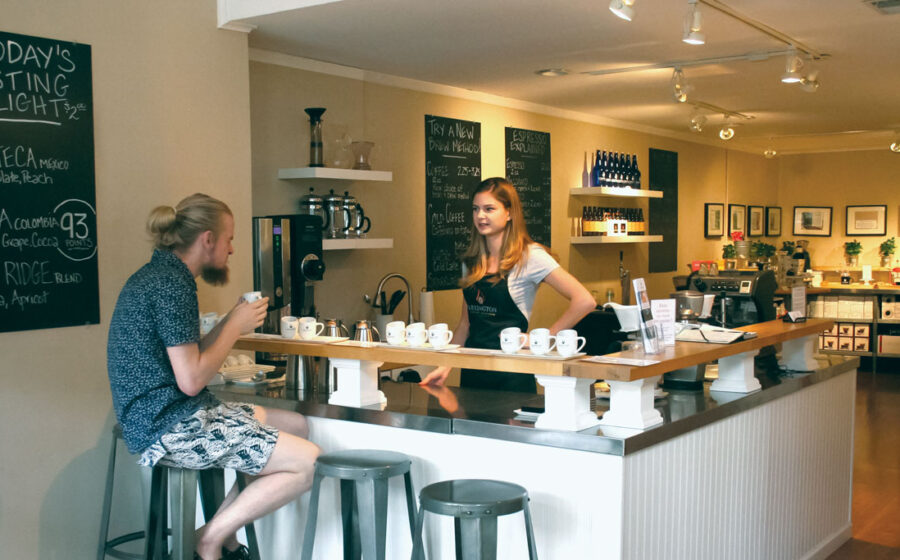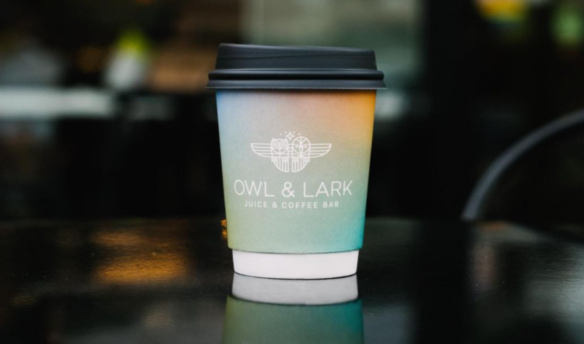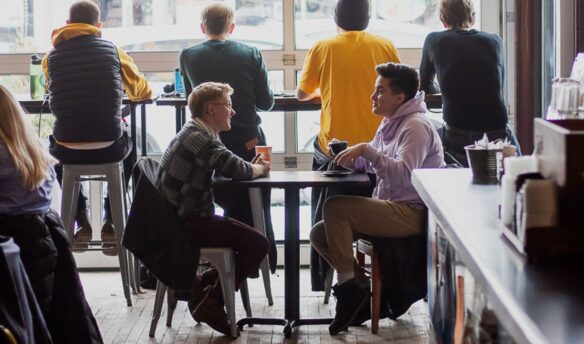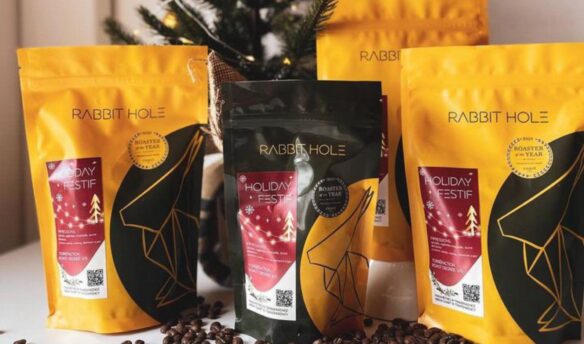[S]ipping coffee, for many, is a solitary experience best partaken early in the morning, as grogginess turns into caffeinated geniality. But discerning café owners recognize that coffee, with its rich, varied flavors, can lend itself to a more involved sipping session. Enter: the coffee tasting flight.
Coffee shops and roasters ahead of the curve are offering up tasting flights, a trio or more of small servings of exciting brews. In some cases, a knowledgeable barista guides tasters through each cup, much like how a sommelier at a wine bar or winery would talk customers through the flavor profiles of each glass in a wine flight. These tastings allow customers to experience coffee in a new, likely deeper, way, providing a better understanding of the drink and forging allegiances to high-quality cups of coffee in the process.
What is a Coffee Flight?
Coffee flights are a multi-beverage experience where three to five coffee drinks are prepared and served at once, side-by-side.
Since few people can down five coffees in one setting, flights are often made up of smaller portions, sometimes as small as 2 ounces. This enables customers to enjoy a sampling of multiple drinks, but not become overwhelmed with caffeine.
Coffee flights can be made up any type of drink, from black coffee to espresso drinks to cold brew. Here are a few examples you’re likely to see:
- Black Coffee Flight — Coffees made from different brewing methods, like drip, pour over, french press, and espresso
- Latte Flight —A series of lattes showcasing various flavors a coffee shop makes
- Cold Brew Flight —Multiple single origin coffees offered as cold brew to see how cold brewing impacts flavor for different coffees
Since flights are all about the sense of flavor exploration and discovery through side-by-side tasting, coffee brands have the freedom to design whatever types flights they want.
The Power of Tasting Side-by-Side
Serving different coffees side-by-side helps even long-time coffee drinkers develop their coffee-tasting muscles. “What we’re trying to do is help people discern those flavors they read about on a label,” says Melissa Scholl, owner of Roadmap CoffeeWorks (formerly Lexington Coffee Roasters) in Lexington, Virginia. “So many people think that ‘coffee just tastes like coffee,’ especially if they only drink dark roast. They get confused when a label starts talking about ‘blueberry,’ ‘apricot,’ or ‘molasses.’”
To demystify coffee’s many flavors, Scholl offers tasting flights as part of her coffee program at Roadmap’s downtown location. For two dollars, customers can order a coffee flight with three brews; each served in a two-ounce glass. Flights are highly customizable, depending on the customer’s desire and level of interest. A barista may whip up a flight of brewed coffees with distinct flavors, an all-espresso flight, or even serve one kind of coffee brewed via several different methods (think pour-over versus AeroPress versus batch-brew machine).
In the summer months, baristas cap off a flight with a quick taste of bottled cold-brew coffee, “kind of like how a winery may bring out a little sweet dessert wine to end a flight,” says Scholl.
The key to a successful tasting flight, according to Scholl, is not to leave the customer floundering. “Our barista will talk the customer through the criteria of aroma, flavor, acidity, body, finish, and balance,” explains Scholl. “How much info she gives beyond that depends on the customer’s interest level since we don’t want to overwhelm them. But the barista will show the customer how to get their nose down and get a whiff, identify the different aromas they’re smelling, and slurp and spread the coffee across the tongue.”
Offering tasting flights is also great for coaxing customers out of their comfort zones. Chelsey Walker-Watson, formerly of Slate Coffee Roasters and now at Atlas Coffee, has found that customers are more likely to take a chance on a new brew when they only have to commit to two ounces of it.
“If we know a customer likes a classic dark roast, then we’ll serve them a flight that features light roast American coffee but with caramel-y, chocolate-y undertones,” says Watson, who offers tasting flights that often feature four or five different coffees. “We’ll meet them halfway with something they’re more comfortable and familiar with, but that’s still new to them.”
Scholl and Watson agree that coffee flights should be fun, intimidation-free, and accessible to customers who identify as coffee enthusiasts but not experts—the more technical cuppings that many coffee professionals are familiar with are a bit out of reach for the average customer. “We want to intrigue our visitors,” says Scholl, “but we never want them to worry about looking stupid or asking the wrong questions. We want to introduce our customers to the tasting experience in a welcoming way, the same way a hostess would invite a guest at a party to try something new.”
Beyond Your Everyday Order
Incredible educational service through coffee flights has paid off. Scholl says that while offering tasting flights hasn’t changed the buying habits of long-time customers (“the kind who’ve been buying Italian roast for twenty-four years”), it has resulted in more sales of single-origin beans in particular.
Scholl credits the coffee flights with helping her downtown location become a popular stop on the tourist circuit. “We’re a small town with a lot of Civil War history, so Lexington gets a lot of out-of-town visitors. We were surprised to find that when our regular customers have guests in town, they’ll bring them here for a tasting flight,” Scholl explains. “It has helped make us part of the fabric of what goes on here.”
Watson also credits coffee flights for both increased sales and an increase in visitors. “It’s so frequent that people do a coffee flight and then take home a bag of beans featured that I think there’s an inextricable link,” she says. “I also see our regulars bringing in their friends and family for a flight, and people appreciate the experiential element.”
In Washington, DC, Qualia Coffee’s twice-monthly guided tasting flights in the roasting room are always packed with regulars. Owner and head roaster Joel Finkelstein notes that since many of the people who attend tastings are already Qualia devotees, offering the flights isn’t about building customer loyalty. Instead, he aims to encourage customers to make informed, sustainable choices about their beans—whether they purchase from Qualia or elsewhere.
An Educational Experience
For Finkelstein, customer education boils down to helping people appreciate the broad spectrum of coffees available. At his tastings, he’ll often pair coffees from different regions or coffees from the same farm that have been processed differently, like a natural- and a honey-processed. “When people get hooked on only drinking one type of coffee, they want consistency—but coffee’s not a naturally consistent product,” he says. “My coffee flights open people up to the dynamic quality of coffee.”
Using flights to educate customers on coffee’s diversity of flavors isn’t just benefiting the customer’s palate or the coffee shop’s bottom line, says Finkelstein—it’s good for the specialty coffee community as a whole.
“When people are satisfied with buying poorly produced coffees, that doesn’t help the coffee community in general,” he says. “My goal with these flights is not just to bring customers to me, but to bring customers to the farmers. It’s important to build customer knowledge, so people are buying good, sustainable coffee—which creates a feedback loop where farmers are being paid better and can continue to produce good quality beans.”
Offering flights, which require intense involvement and superior knowledge from baristas, can present a challenge to some coffee shops or roasters. “Your service model dictates if coffee flights will work for you,” says Walker-Watson. “If you’re going to serve flights, I think that’s dependent on the fact that you don’t have a line or that you’re able to step away from brewing for a while.”
Ready for Takeoff
Scholl set up her downtown location primarily as a retail space stocked with beans and brewing equipment, which has made offering tasting flights far easier. “We only have four stools at the bar where we offer tasting flights,” she explains. “So when things get busy, our customers will browse around the store and wait their turn while the barista sets up tastings.”
At Qualia, Finkelstein has avoided the “operating the bar” problem by only offering guided flights twice a month, always at the same time—the second and fourth Sundays at two p.m. He says he’s working towards being able to offer flights as part of Qualia’s regular menu but doesn’t currently have the resources. He’s looking into investing in a Poursteady, an automated pour-over coffee machine that would free baristas up to offer more flights.
Another obstacle is getting the word out about your coffee flight offerings. While Finkelstein started Qualia’s coffee flight program three years ago, he had to go on hiatus with the program not long after it launched due to a lack of interest. When he started the program again two years ago, however, participation soared—partly from his efforts to reach out to local foodie blogs for press coverage.
Participation has remained active since then, much to Finkelstein’s pleasure. “I personally really enjoy discovering new coffees,” says Finkelstein, “so I love that I can build that knowledge base for customers through flights and help them understand the time, effort, and hard work that goes into producing quality coffee.”
Emily Matras is a freelance writer based in Washington, DC. Featured photo courtesy Amira Hegazy.
This article was originally published in the November 2015 issue of Fresh Cup Magazine. It has been updated to reflect Fresh Cup’s current editorial standards.

















